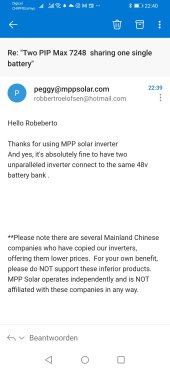Hello,
I have been reading this site, watching YouTube videos and thinking and researching about my plan to add back-up grid down power to my existing setup for a few months. The amount of information I have learned from everyone on here has been extremely helpful!
I currently have an 8.82kW array going through a SolarEdge inverter (installed 4 years ago by a well known national solar installer). My house has 2 separate (side by side) 200A service panels. I have read many threads about dealing with two main panels and long story short I think the way I want to go is to power each panel totally independently with different inverters using interlocks on each panel. This is simple and straight forward and avoids the whole multiple ground-neutral bonds situation.
Because of my existing solar, I was looking toward Sol-Ark for the AC coupling capability to easily integrate things. I reached out to Sol-Ark asking if 2 Sol-Arks powering separate panels could share the same battery, and they provided a single sentence response saying unless both inverters are connected they cannot use the same battery. There was no elaboration if this meant they just needed to be connected via the communication cables, or actually to the same panel. Unless I missed it I didn't see anything in their documentation mentioning this type of setup.
I wouldn't have minded a more technical explanation, especially as I was considering buying two of them, but since then I decided that a more cost effective option might be to purchase a single Sol-Ark, use that for my AC coupling/battery charging, and then a second much cheaper inverter (such as a Sungold 6000W LFP) that would power the other panel. The only thing shared between them would be the bank of 6 EG4 48V 100Ah batteries. I wouldn't even bother hooking up AC input to the other inverter and just let the Sol-Ark handle the battery charge. Furthermore since my intention is to only ever use this in a grid outage situation I could just leave the second inverter powered off until it is needed.
I haven't found anything to lead me to believe that this type of setup would not be possible, however most people with multiple inverters use them in parallel to power the same panel so this is somewhat different. I have already purchased the batteries, and though I could set them up as 2 batteries I would prefer to use them as one battery.
If anyone has any thoughts as to whether or not this would work or have a better suggestion I would love to hear it. Thanks!
I have been reading this site, watching YouTube videos and thinking and researching about my plan to add back-up grid down power to my existing setup for a few months. The amount of information I have learned from everyone on here has been extremely helpful!
I currently have an 8.82kW array going through a SolarEdge inverter (installed 4 years ago by a well known national solar installer). My house has 2 separate (side by side) 200A service panels. I have read many threads about dealing with two main panels and long story short I think the way I want to go is to power each panel totally independently with different inverters using interlocks on each panel. This is simple and straight forward and avoids the whole multiple ground-neutral bonds situation.
Because of my existing solar, I was looking toward Sol-Ark for the AC coupling capability to easily integrate things. I reached out to Sol-Ark asking if 2 Sol-Arks powering separate panels could share the same battery, and they provided a single sentence response saying unless both inverters are connected they cannot use the same battery. There was no elaboration if this meant they just needed to be connected via the communication cables, or actually to the same panel. Unless I missed it I didn't see anything in their documentation mentioning this type of setup.
I wouldn't have minded a more technical explanation, especially as I was considering buying two of them, but since then I decided that a more cost effective option might be to purchase a single Sol-Ark, use that for my AC coupling/battery charging, and then a second much cheaper inverter (such as a Sungold 6000W LFP) that would power the other panel. The only thing shared between them would be the bank of 6 EG4 48V 100Ah batteries. I wouldn't even bother hooking up AC input to the other inverter and just let the Sol-Ark handle the battery charge. Furthermore since my intention is to only ever use this in a grid outage situation I could just leave the second inverter powered off until it is needed.
I haven't found anything to lead me to believe that this type of setup would not be possible, however most people with multiple inverters use them in parallel to power the same panel so this is somewhat different. I have already purchased the batteries, and though I could set them up as 2 batteries I would prefer to use them as one battery.
If anyone has any thoughts as to whether or not this would work or have a better suggestion I would love to hear it. Thanks!



